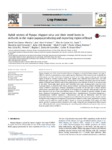Use este identificador para citar ou linkar para este item:
http://biblioteca.incaper.es.gov.br/digital/handle/item/2353Registro completo de metadados
| Campo DC | Valor | Idioma |
|---|---|---|
| dc.contributor.author | MARTINS, D. dos S. | pt_BR |
| dc.contributor.author | MARTINS, D. dos S. | pt_BR |
| dc.contributor.author | PAULA, R. de C. A. L. | pt_BR |
| dc.contributor.author | FORNAZIER, M. J. | pt_BR |
| dc.contributor.author | REZENDE, J. A. M. | pt_BR |
| dc.contributor.author | CULIK, M. P. | pt_BR |
| dc.contributor.author | FERREIRA, P. S. F. | pt_BR |
| dc.contributor.author | PERONTI, A. L. B. G. | pt_BR |
| dc.contributor.author | CARVALHO, R. C. Z. de. | pt_BR |
| dc.contributor.author | SOUSA-SILVA, C. R. | pt_BR |
| dc.contributor.other | David dos Santos Martins, Incaper; David dos Santos Martins, Incaper; Rita de Cassia A.L. Paula, Universidade Estadual do Sudoeste da Bahia; Mauricio José Fornazier, Incaper; Jorge A.M. Rezende, ESALQ; Mark Paul Culik, CNPq/Incaper; Paulo S.Fiuza Ferreira, UFV; Ana Lúcia B.G. Peronti, UNESP; Regina C. Zonta de Carvalho, Centro de Diagn ostico Marcos Enrietti; Carlos R. Sousa-Silva, UFSCAR. | pt_BR |
| dc.date.accessioned | 2016-10-03T13:02:33Z | - |
| dc.date.available | 2016-10-03T13:02:33Z | - |
| dc.date.created | 2016 | pt_BR |
| dc.date.issued | 2016-10-03 | pt_BR |
| dc.identifier.other | 13286 | pt_BR |
| dc.identifier.uri | http://biblioteca.incaper.es.gov.br/digital/handle/item/2353 | - |
| dc.description | Papaya ringspot, one of the most important diseases of papaya, is caused by Papaya ringspot virus type P (PRSV-P), which is transmitted by various aphid species. Objectives of this research were to identify the aphid species and their weed hosts of papaya orchards in the major papaya producing and exporting region of Brazil in northern Espírito Santo State. Aphids were collected from weed hosts, and with Möericke-type traps in papaya orchards of twenty farms in Linhares, Sooretama and Aracruz municipalities of Espírito Santo, Brazil. A total of forty aphid species were collected, of which 22 are new records in the State. Thirty-eight aphid species were identified from traps, including Aphis craccivora Koch, A. gossypii Glover, A. spiraecola Patch, Myzus persicae (Sulzer), and Toxoptera citricidus (Kirkaldy), known vectors of PRSV-P. Cryptomyzus Oestlund (Aphididae) is recorded for the first time in Brazil. Thirteen aphid species associated with 22 weed species of 14 families were collected. Aphis gossypii, which has been reported to be one of the most efficient vectors of PRSV-P, infested the greatest number of weed hosts. Chamaesyce hyssopifolia (L.) Small, Euphorbia hirta L. (Euphorbiaceae), Commelina benghalensis L. (Commelinaceae), Lepidium virginicum L. (Brassicaceae) and Sida sp. (Malvaceae) were the most frequently infested weeds. Commelina benghalensis was infested by the greatest number of aphid species during this study. Integrated management of weed hosts of aphids to reduce aphid populations in papaya orchards may be useful for control of PRSV-P. Based on accurate knowledge of the aphid and weed species present in papaya orchards obtained in this study, integrated pest management efforts may be more efficiently directed toward eliminating the most frequently infested weed species that serve as hosts for aphid vectors of PRSV-P. | pt_BR |
| dc.language | pt_BR | pt_BR |
| dc.publisher | CROP PROTECTION, v. 90, p. 191 196, 2016. | pt_BR |
| dc.subject | Mamão | pt_BR |
| dc.title | Aphid vectors of Papaya ringspot virus and their weed hosts in orchards in the major papaya producing and exporting region of Brazil. | pt_BR |
| dc.type | -- | pt_BR |
| dc.ainfo.id | 12511 | pt_BR |
| dc.ainfo.lastupdate | 2016-10-03 | pt_BR |
| dc.ainfo.depositante | Merielem Frasson | pt_BR |
| dc.subject.nalthesaurus | Carica papaya | pt_BR |
| dc.subject.nalthesaurus | Epidemiology | pt_BR |
| dc.subject.nalthesaurus | Management tactics | pt_BR |
| dc.subject.nalthesaurus | Potyvirus | pt_BR |
| dc.subject.nalthesaurus | Virus transmission | pt_BR |
| dc.subject.nalthesaurus | Weed hosts | pt_BR |
| Aparece nas coleções: | Memória Técnica do Incaper  | |
Arquivos associados a este item:
| Arquivo | Descrição | Tamanho | Formato | |
|---|---|---|---|---|
| BRT-aphidsvectorofPRSV-CropProtection-ventura.pdf | 700,69 kB | Adobe PDF |  Visualizar/Abrir |
Os itens no repositório estão protegidos por copyright, com todos os direitos reservados, salvo quando é indicado o contrário.
